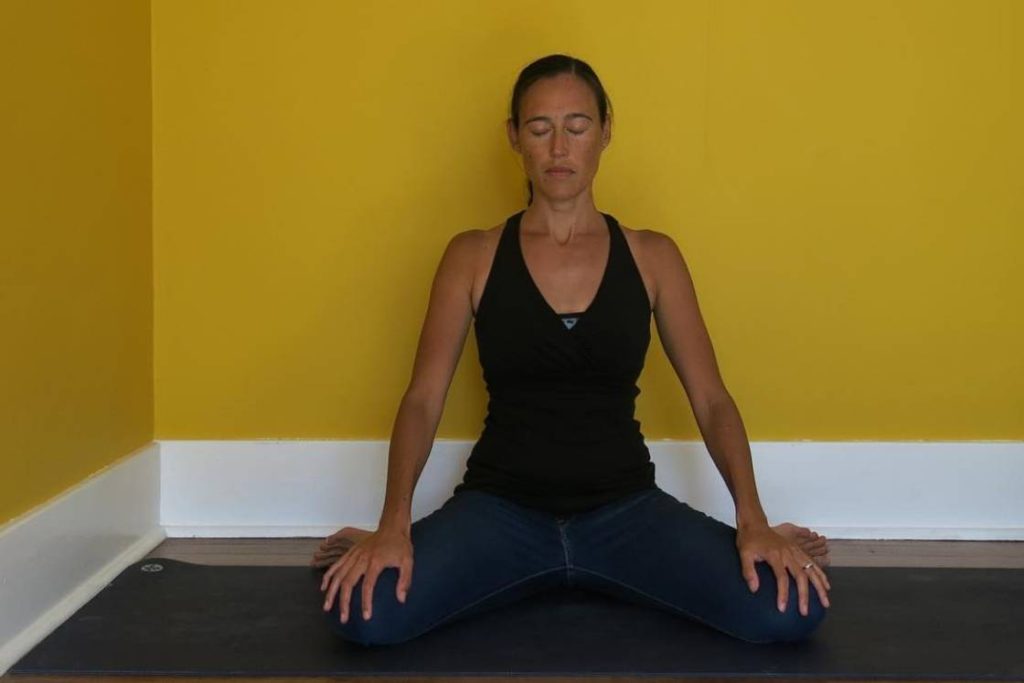
Manduki means frog and mudra refer to gesture or seal. While sitting in the Manduki mudra the body mimics a frog’s posture in rest, hence the name. It is also well known as “Gesture of the Frog” or “Frog Attitude.”
Manduki Mudra is a type of Kaya yoga mudras (postural gesture) that take the entire body into account from the toe tip to the top of the head.
In this mudra, the lower body takes Mandukasana posture and in the upper body, the tongue is rotated inside the closed mouth. Performing it allows your taste buds to experience nectar flowing from the brain and reaching every cell of the body.
The technique
Manduki mudra is performed in a sitting posture, preferred in a kneeling position like Vajrasana or Bhadrasana. Then with focused breathing, awareness is shifted to the tongue tip simultaneously tongue is rolled to the mouth palate. Gradually, the tongue is rotated to the left and right sides of the mouth.
However, in Kundalini kriyas, the Manduki mudra technique involves holding the Nasikagra Drishti in Bhadrasana. This mudra is the eighth technique involved in the Kundalini Kriyas of Kriya yoga. Hence, also referred to as Manduki kriya.
Manduki mudra has a great significance as a yogic practice. It is mentioned in traditional texts like Gheranda Samhita.
Closing the mouth, move the tip of the tongue towards the palate, and slowly taste the nectar (flowing from thousand-petalled lotus). This is frog mudra.
Gheranda Samhita 3.62
Also, in the sacred Upanishads, it’s considered helpful in the stimulation of the facial organs.
To reap the maximum benefits from this mudra seek assistance from following steps:
How to Do Manduki Mudra
- Sit in Bhadrasana (gracious pose) keeping the toes pointed outward. If not comfortable with this pose, sit in Vajrasana.
- The buttocks must be kept in contact with the floor so that the perineum feels gentle pressure. For easy sitting, place a cushion or blanket under the buttocks to sit upon. It stimulates the Muladhara chakra.
- Put your hands on your knees keeping the head and spine straight.
- Close your eyes and relax the whole body.
- Keep the mouth closed and touch the tip of the tongue to the palate rotating it into clockwise and anticlockwise directions three times each.
- Relax your jaw for a while.
- Now, open your eyes to perform Nasikagra Drishti i.e. gaze at the tip of the nose.
- When the eyes are tired, relax them by shutting them for a few seconds.
- Continue this practice for 5 minutes until the mind and senses are drawn inward.
Additional tips
- Practice Manduki mudra in a mild light to easily focus on the tip of the nose without straining the eyes.
- Perform the practice for an optimum of 5 minutes. However, in beginning, it should be limited up to 2 minutes in one sitting.
- Keep your attention on the breathing pattern that must be kept slow and deep.
- Shift your focus physically on the nose tip and slowly as you close your eyes, shift it down to Muladhara chakra.
- This mudra follows a sequence that it must be practiced after Maha bheda mudra and before Tadan Kriya.
Contraindications and precautions
- People having glaucoma can skip nasikagra drishti part from this mudra.
- Avoid it if you are suffering from diabetic retinopathy.
- Do not try Manduki Mudra if you’ve undergone an eye operation.
- Make sure that your hips, knees, and ankles are flexible enough to practice this gesture.
Modifications and alterations
You can make adjustments in sitting posture in the following three manners.
- Instead of sitting in Bhadrasana with toes pointing outward, you can keep them towards each other with soles pointing upward. Then follow the above-given technique.
- If Bhadrasana is not comfortable enough you can sit in Vajrasana.
- To ease the pose you can keep a folded blankets under the buttocks to stimulate the Muladhara chakra.
Manduki Mudra Benefits
1. Relaxes the mind – Manduki mudra is beneficial in calming the mind. Also, the brain gets exercised holding this mudra that enhances the insight levels.
2. Delays aging & prevent graying of hair – Yogis believe Manduki mudra stimulates the nectar present in Bindu. The nectar that flows from the top of the head prevents the greying of the hair. Besides this rotating the tongue inside the mouth tones the facial muscles keeping the wrinkles at the bay.
Hence, manduki mudra is beneficial in keeping the skin glowing at its best.
3. Aids in digestion – Holding Manduki mudra enhances the secretion of the saliva. It helps in increasing the appetite and also helps in better digestion.
4. Enhances the sense of taste – The taste buds are also enhanced through this practice due to getting the taste of the nectar. Along with this, the strength of the tongue is also promoted.
5. Strengthens the throat muscles – Manduki mudra is also known for its soothing effects on the throat. It revitalizes the throat region and benefits it in a long run.
6. Stimulates Muladhara chakra – Frog gesture is attained by exerting mild pressure on the perineum. This helps in stimulating the Muladhara chakra and benefits on an energetic level. It promotes the growth and vigour.
Besides these, activation of the root chakra strengthens the practitioner physically and spiritually.
7. Regulates pranic flow – Manduki mudra revitalizes the energy channels through which prana flows. It balances the Ida and Pingala Nadis and leading to the meditative state.
8. Strengthens the leg muscles – Frog gesture also involves yoga asana that enhances the strength of the hips, knees, and ankles. It stretches these muscles makes them flexible.
Conclusion
Manduki mudra is a sure shot to get a healthy body physically, mentally, emotionally, and spiritually.
Get into into practice and enjoy the vigor that it provides in return.




